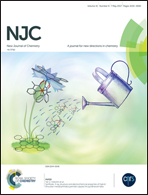Development of (quinolinyl)amido-based pincer palladium complexes: a robust and phosphine-free catalyst system for C–H arylation of benzothiazoles†
Abstract
(Quinolinyl)amido-ligated palladium(II) complexes have been synthesized and applied in the catalytic C–H bond arylation of benzothiazoles. The tridentate ligand precursors R2N-C(O)CH2-(NH)-C9H6N [(R2NNN8-Q)–H; R2N = morpholinyl, Me-N-piperazinyl] and the pincer palladium complexes [κN,κN,κN-{R2N-C(O)CH2-(μ-N)-C9H6N}]PdX [(R2NNN8-Q)PdX {R2N = Et2N, morpholinyl, Me-N-piperazinyl; X = OAc or Cl}] were efficiently synthesized, and characterized by various analytical techniques. The iodo derivative (Et2NNN8-Q)PdI was obtained in excellent yield by the treatment of the complex (Et2NNN8-Q)PdCl with KI. The molecular structures of complexes (Et2NNN8-Q)Pd(OAc) (2a), (Et2NNN8-Q)PdCl (3a) and (Et2NNN8-Q)PdI (4a) were elucidated by X-ray crystallography. Complex 3a was found to be the most efficient catalyst for direct C–H bond arylation of substituted benzothiazoles with diverse aryl iodides using a mild base, K2CO3. The working catalyst system 3a is highly robust and can be recycled and reused several times for the arylation of benzothiazole without loss of catalytic activity. Preliminary mechanistic investigations using controlled studies and kinetic analysis have been performed, which greatly support a molecular mechanism for the arylation.



 Please wait while we load your content...
Please wait while we load your content...